Welcome to our comprehensive guide on caring for Cryptocoryne Lucens, a beautiful aquatic plant species. Whether you’re a beginner or an experienced aquarist, this article will provide you with all the information you need to ensure the healthy growth of Cryptocoryne Lucens in your aquarium.
Cryptocoryne Lucens, also known as the “willow leaf” Cryptocoryne, is a popular choice for aquarium enthusiasts.
With its long, slender leaves resembling the leaves of a willow tree, Cryptocoryne Lucens adds a touch of elegance to any aquatic setup.
Not only is it visually appealing, but it is also relatively low-maintenance, making it an ideal choice for both beginners and experienced aquarists.
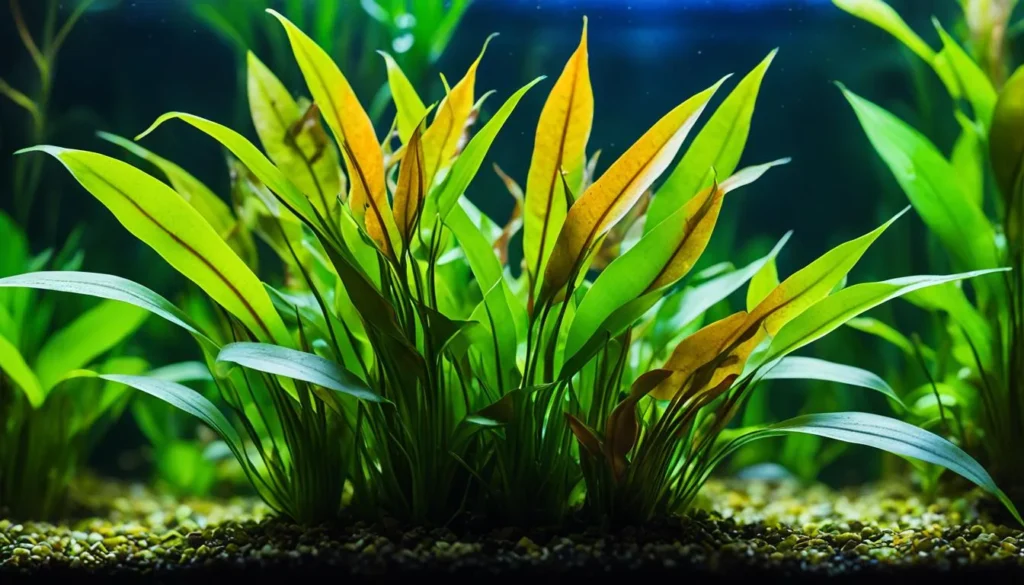
Key Takeaway
- Cryptocoryne Lucens is a beautiful aquatic plant species that adds elegance to any aquarium.
- It is relatively low-maintenance and suitable for both beginners and experienced aquarists.
- This guide will cover important aspects of caring for Cryptocoryne Lucens, including plant placement, substrate requirements, water conditions, lighting, water temperature, pH levels, propagation methods, and more.
- By following our care tips, you can ensure the healthy growth of Cryptocoryne Lucens in your aquarium.
- Stay tuned for our detailed sections on each aspect of Cryptocoryne Lucens care and growth.
Quick Stats
| Attribute | Details |
| Family Name | Araceae |
| Origin | Sri Lanka |
| Height | 5-10 cm (2-4 inches) |
| pH Range | 6.0 – 8.0 |
| CO2 Requirement | Low |
| Growth Rate | Slow |
| Care Level | Easy |
| Color Form | Green, with narrow, lance-shaped leaves |
| Water Conditions | 22-28°C (72-82°F), adaptable to a wide range of hardness |
| Max Size | Leaves can grow up to 10 cm (4 inches) long |
| Lighting | Low to Medium |
| Supplements | Root tabs beneficial; tolerates a wide range of nutrient levels |
| Placement | Foreground to Mid-ground |
| Propagation | By runners |
What Is Cryptocoryne Lucens?
Cryptocoryne Lucens, also known as the “willow leaf” Cryptocoryne, is a popular aquarium plant species in the family Araceae. Native to Southeast Asia, it is characterized by its long, slender leaves that resemble those of willow trees.
Cryptocoryne Lucens is highly favored by both beginner and experienced aquarists due to its low-maintenance requirements and attractive appearance in aquariums.
Natural Habitat And Origin
Cryptocoryne lucens, commonly known as the “Green Crypt,” originates from the tropical regions of Southeast Asia. It is native to countries such as Sri Lanka, India, and Bangladesh, where it typically grows in marshy areas, riverbanks, and shallow streams.
In its natural habitat, Cryptocoryne lucens thrives in submerged conditions with moderate water flow and nutrient-rich sediment.
The plant is well-adapted to tropical climates, where it benefits from warm temperatures, ample sunlight, and stable water parameters.
Cryptocoryne lucens is a popular choice among aquarists for its vibrant green foliage and relatively undemanding care requirements, making it suitable for both beginners and experienced hobbyists alike.
Physical Characteristics
Leaves: The leaves of Cryptocoryne lucens are typically narrow, lanceolate, and have a vibrant green coloration. They grow from a central rosette and can vary in length, with mature leaves reaching around 10-15 centimeters (4-6 inches) in length.
The leaves may feature slightly wavy margins and may be either solid green or have subtle reddish undertones, especially under high light conditions.
Rhizome: Like other Cryptocoryne species, Cryptocoryne lucens possesses a creeping rhizome from which the leaves emerge.
The rhizome is typically buried in the substrate, with roots extending downwards to anchor the plant and absorb nutrients.
Growth Habit: Cryptocoryne lucens has a relatively slow growth rate compared to other aquarium plants, making it well-suited for low-maintenance setups.
It tends to form dense clumps of foliage over time, creating a lush and natural appearance in the aquarium.
The plant may propagate through the production of offshoots or runners from the rhizome, allowing it to spread gradually within the aquarium.
RELATED: Grow Cryptocoryne Lutea For Vibrant Aquariums With This Simple Guide
Lighting Requirements For Optimal Growth
- Cryptocoryne Lucens requires a consistent lighting duration to thrive. We recommend providing this plant species 8 to 10 hours of light per day.
- This duration mimics natural daylight cycles and allows for sufficient energy production through photosynthesis.
- Avoid prolonged periods of darkness or excessive exposure to artificial light, as it may negatively impact the growth and health of your Cryptocoryne Lucens.
Recommended Lighting Intensity
- The lighting intensity for Cryptocoryne Lucens should be moderate to low. Aim for an intensity of around 30-50 PAR (Photosynthetic Active Radiation).
- This level of light penetration is ideal for allowing the plant to photosynthesize efficiently without risking excessive algae growth.
- Investing in a quality aquarium light fixture with adjustable intensity settings or using low-energy LED lights can help achieve the desired lighting intensity for your Cryptocoryne Lucens.
Water Conditions And Quality
- Cryptocoryne Lucens thrives in slightly acidic to neutral water conditions with a pH range of 6.0-7.5. Stable water parameters are important to avoid stressing the plant. Regular water testing and monitoring are essential to ensure the proper balance of pH, ammonia, nitrite, and nitrate levels.
- Regarding water hardness, Cryptocoryne Lucens prefers soft to moderately hard water with a dGH of 5-15. A high-quality liquid fertilizer formulated for aquatic plants can help supplement essential nutrients and promote healthy growth.
- In the next section, we will delve into the lighting requirements for optimal growth of Cryptocoryne Lucens.
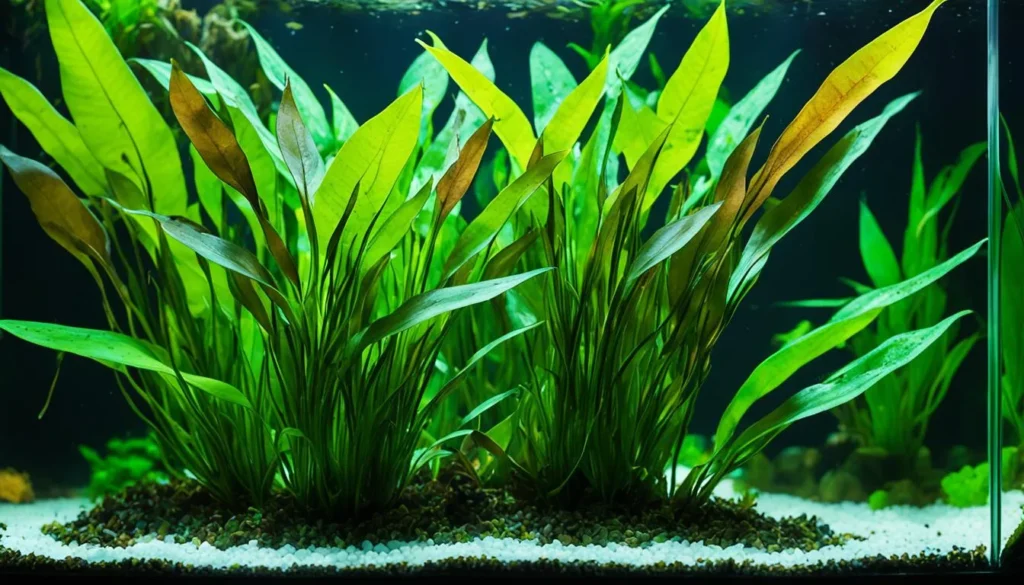
Water Temperature Range For Cryptocoryne Lucens
- Cryptocoryne Lucens is a tropical plant species that requires a specific water temperature range to thrive and maintain optimal health in your aquarium. The ideal water temperature for Cryptocoryne Lucens is between 72°F (22°C) and 82°F (28°C).
- It is important to note that maintaining a stable temperature within this range is crucial for the well-being of Cryptocoryne Lucens. Fluctuations in water temperature can cause stress and negatively impact the plant’s growth and overall health.
- Stable temperature is especially important because Cryptocoryne Lucens originates from tropical regions, where the water temperature remains relatively consistent throughout the year. You can create the best conditions for the plant’s growth by mimicking this stable environment in your aquarium.
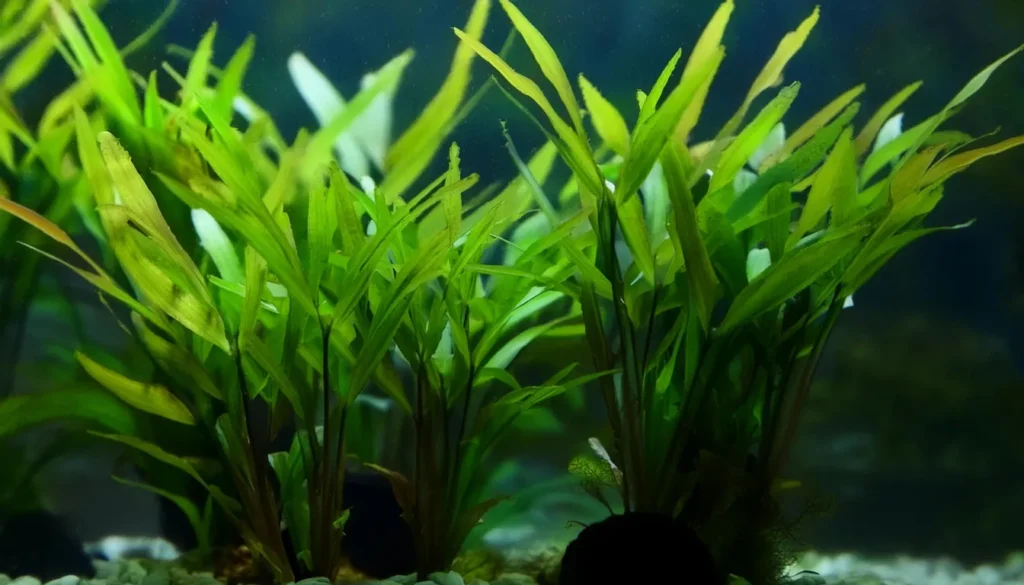
| Temperature Range | Effect on Cryptocoryne Lucens |
| Below 72°F (22°C) | Cryptocoryne Lucens may become sluggish and exhibit slow growth. |
| Above 82°F (28°C) | High temperatures can stress Cryptocoryne Lucens, leading to leaf melt and root rot. |
| Fluctuating Temperatures | Erratic water temperature fluctuations can cause Cryptocoryne Lucens to weaken and become susceptible to diseases. |
Substrate Requirements
- Fine-Grained Substrate: Cryptocoryne lucens benefits from a substrate with a fine-grained texture, such as aquarium sand or fine gravel. A substrate with smaller particle sizes provides stability for the plant’s roots and allows for proper anchoring without impeding root growth.
- Nutrient-Rich Substrate: While Cryptocoryne lucens can extract nutrients from the water column, it also benefits from a nutrient-rich substrate. Consider using an aquarium substrate specifically formulated for aquatic plants or incorporating root tabs into the substrate. These root tabs slowly release essential nutrients such as iron, potassium, and trace elements directly to the plant’s roots, promoting healthy growth and vibrant foliage.
Depth: Provide an adequate substrate depth to accommodate Cryptocoryne lucens’ root system. Aim for a substrate depth of at least 2-3 inches (5-8 centimeters) to allow the plant’s roots to spread and anchor securely. Deeper substrate layers can also help prevent the plant from being uprooted by bottom-dwelling fish or water movement.
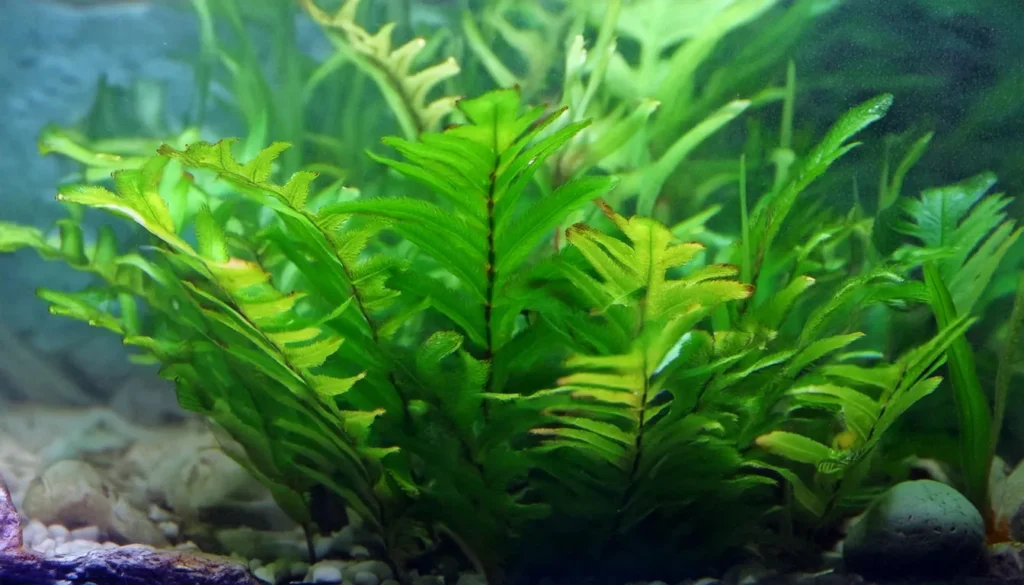
Placement In The Tank
- Foreground to Midground: Cryptocoryne lucens is often placed in the foreground to midground areas of the aquarium, depending on its size and the layout of your tank. Its relatively compact size and slow growth make it suitable for these positions, where it can complement other foreground or midground plants.
- Grouping: Cryptocoryne lucens looks best when planted in groups or clusters rather than as individual specimens. Planting multiple Cryptocoryne lucens together can create a lush carpet effect, adding visual interest and depth to the aquariumscape.
- Spacing: Provide adequate spacing between Cryptocoryne lucens plants to allow for proper growth and prevent overcrowding. Aim for spacing of a few inches between each plant to ensure they have enough room to spread and develop without competing for resources.
Recommended Tank Size
- Nano Tanks: For smaller tanks such as nano aquariums or tanks under 10 gallons, Cryptocoryne lucens can be a suitable choice, especially when planted in the foreground or midground areas. Ensure adequate spacing and avoid overcrowding to maintain a balanced ecosystem.
- Small to Medium Tanks: Tanks ranging from 10 to 30 gallons provide ample space for cultivating Cryptocoryne lucens along with other compatible plants and fish species. The size of the tank allows for more flexibility in aquascape design and stocking options while still accommodating the plant’s growth requirements.
- Large Tanks: In larger aquariums exceeding 30 gallons, Cryptocoryne lucens can be incorporated as part of a diverse and expansive aquascape. These tanks offer plenty of room for planting multiple clusters of Cryptocoryne lucens and experimenting with different layout configurations.
RELATED: Crinum Calamistratum Care Guide & Tips For Beginners
Suitable Tank Mates
- Community Fish: Many peaceful community fish species can thrive alongside Cryptocoryne lucens. Examples include tetras (such as neon tetras, cardinal tetras, and ember tetras), rasboras, guppies, mollies, platies, and small peaceful catfish like Corydoras species.
- Shrimp: Freshwater shrimp, such as cherry shrimp, amano shrimp, and ghost shrimp, make excellent tank mates for Cryptocoryne lucens. They help keep the aquarium clean by consuming algae and detritus, and they generally do not bother the plants.
- Snails: Snails like nerite snails and Malaysian trumpet snails can also be compatible with Cryptocoryne lucens. They assist in algae control and substrate aeration without causing harm to the plants.
- Bottom Dwellers: Bottom-dwelling fish species that are compatible with the plant’s requirements can make suitable tank mates. This includes species like dwarf cichlids (such as Apistogramma), small loaches (such as kuhli loaches and dwarf chain loaches), and bottom-feeding catfish like Otocinclus and small species of plecos.
CO2 Additions For Cryptocoryne Lucens
- CO2 additions can greatly benefit the growth and vitality of Cryptocoryne Lucens in your aquarium. Providing supplemental CO2 can enhance the plant’s photosynthesis process and support its overall health. While CO2 supplementation is not necessary for all aquarium plants, it can significantly affect certain species like Cryptocoryne Lucens.
- CO2 is a crucial element for aquatic plants as it aids in the conversion of light energy into chemical energy. This process, known as photosynthesis, allows plants to synthesize carbohydrates and grow. With adequate CO2 levels, plants may be able to carry out photosynthesis efficiently, resulting in slower growth and suboptimal health.
- When CO2 is added to an aquarium can stimulate Cryptocoryne Lucens’ growth and promote vibrant foliage. CO2 supplementation can lead to faster growth rates, increased leaf production, and more robust roots. It can also enhance coloration, making the plant even more visually striking.
- However, it is important to note that the need for CO2 additions can vary depending on your specific setup and the plants you have in your aquarium. If you have a heavily planted aquarium with high lighting levels, injecting CO2 may be beneficial to maintain a healthy balance and prevent nutrient deficiencies. On the other hand, in a low-tech or low-light setup, CO2 supplementation may not be necessary as the plants can thrive with the available carbon dioxide in the water.

Aquatic Plant Nutrition Requirement
Aquatic plants like Cryptocoryne lucens require both macro and micro nutrients to support their growth and overall health. Here’s a breakdown of these essential nutrients:
Macro Nutrients
- Nitrogen (N): Nitrogen is a crucial component of amino acids, proteins, and chlorophyll, essential for plant growth and photosynthesis. It’s primarily absorbed by plants in the form of nitrate (NO3-) and ammonium (NH4+).
- Phosphorus (P): Phosphorus is vital for energy transfer and cell division in plants. It plays a key role in ATP (adenosine triphosphate) production, DNA synthesis, and root development. Phosphorus is typically absorbed by plants in the form of phosphate (PO4^3-).
- Potassium (K): Potassium regulates water uptake, osmotic pressure, and enzyme activation in plants. It contributes to overall plant vigor, stress resistance, and flower and fruit development.
Micro Nutrients
- Iron (Fe): Iron is essential for chlorophyll synthesis, photosynthesis, and enzyme activation in plants. It plays a critical role in electron transport during photosynthesis and is necessary for the formation of pigments and proteins.
- Magnesium (Mg): Magnesium is a central component of chlorophyll molecules, essential for photosynthesis. It also plays a role in enzyme activation, nucleic acid synthesis, and ion transport within plant cells.
- Calcium (Ca): Calcium is important for cell wall structure and stability in plants. It helps maintain cell membrane integrity, regulates cell division and expansion, and promotes root development.
- Sulfur (S): Sulfur is a component of certain amino acids, vitamins, and coenzymes essential for plant metabolism and protein synthesis. It contributes to overall plant growth, nutrient uptake, and stress tolerance.
Height Predictions And Controlling Growth
- Trimming: Regularly trimming the leaves and stems of Cryptocoryne Lucens can help maintain its desired height. Use sharp, clean scissors to remove any excess growth and promote a compact appearance.
- Pruning: If the plant becomes too large or spreads too quickly, you can selectively remove a portion of the plant’s roots, rhizome, or division to control its growth. Repeat the pruned portions to prevent wastage and promote new growth.
- Lighting adjustment: Controlling the intensity and duration of lighting can influence Cryptocoryne Lucens’s growth rate. Lowering the lighting intensity or reducing the lighting duration can slow down the plant’s growth and help maintain its size.
- Nutrient management: Proper nutrient management, including controlling the availability of macro and micronutrients in the aquarium, can also help regulate Cryptocoryne Lucens’s growth. Adjusting the nutrient levels to match the desired growth rate can help maintain the plant at the desired height.
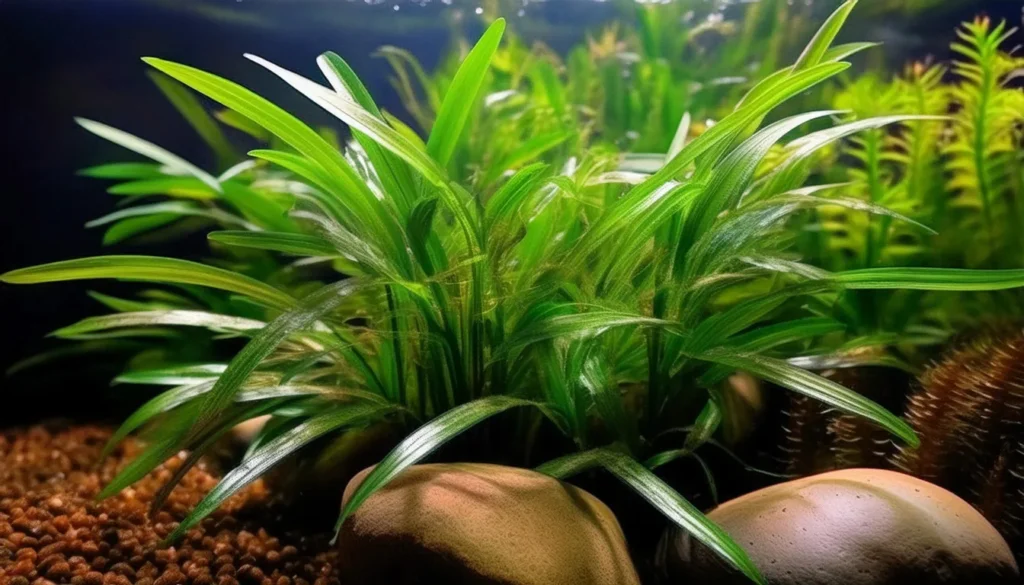
Cultivation Of The Plant
Cultivating Cryptocoryne lucens involves careful preparation for growth, followed by planting and initial care to ensure successful establishment. Here’s a step-by-step guide:
Preparing for Growth
- Selecting a Suitable Tank: Choose an aquarium with appropriate size and lighting conditions for Cryptocoryne lucens. Ensure the tank is fully cycled and stable before adding plants.
- Substrate Selection: Use a nutrient-rich substrate such as aqua soil or fine gravel enriched with root tabs. Cryptocoryne lucens benefits from a substrate that provides essential nutrients for root uptake and supports healthy growth.
- Aquascape Design: Plan the layout of your aquarium, considering the placement of Cryptocoryne lucens in the foreground or midground areas. Create a visually appealing design that allows space for the plant to spread and grow.
Planting
- Preparing the Plant: If you’re planting potted Cryptocoryne lucens, carefully remove it from the pot and gently rinse off excess substrate from the roots. Trim any damaged or brown leaves.
- Planting Technique: Dig small holes in the substrate using your fingers or tweezers, spacing them appropriately according to the desired layout. Plant the Cryptocoryne lucens into the substrate, ensuring the roots are covered and the crown (where the roots meet the stem) is not buried too deeply.
- Spacing: Provide adequate spacing between individual Cryptocoryne lucens plants to prevent overcrowding and allow for proper growth and expansion.
Initial Growth And Care
- Watering: After planting, fill the aquarium with dechlorinated water. Cryptocoryne lucens prefers slightly acidic to neutral water with moderate hardness. Maintain stable water parameters to prevent stress to the plants.
- Lighting: Provide moderate to low lighting for Cryptocoryne lucens. Avoid intense lighting, as it may lead to algae growth or damage the leaves. Adjust the lighting duration to 8-10 hours per day to simulate natural daylight cycles.
- Nutrient Supplementation: Supplement the aquarium with liquid fertilizers or root tabs to provide essential nutrients for Cryptocoryne lucens. Monitor plant growth and adjust fertilization as needed to prevent deficiencies or excesses.
- Maintenance: Perform regular maintenance tasks such as water changes, substrate vacuuming, and algae removal to keep the aquarium environment clean and balanced. Trim any dead or decaying leaves from Cryptocoryne lucens to promote new growth.
Propagation Of Cryptocoryne Lucens
- Gently remove the plant from its existing substrate and rinse off any excess debris.
- Identify natural divisions or offshoots in the plant. These are separate shoots that can be detached and replanted individually.
- Carefully separate the offshoots from the main plant using a sharp, clean knife or scissors. Ensure that each division has a healthy root system attached.
- Plant each division in a separate location in your aquarium, ensuring that the roots are adequately covered with substrate.
- To encourage growth, provide appropriate lighting, water conditions, and care for the newly divided plants.
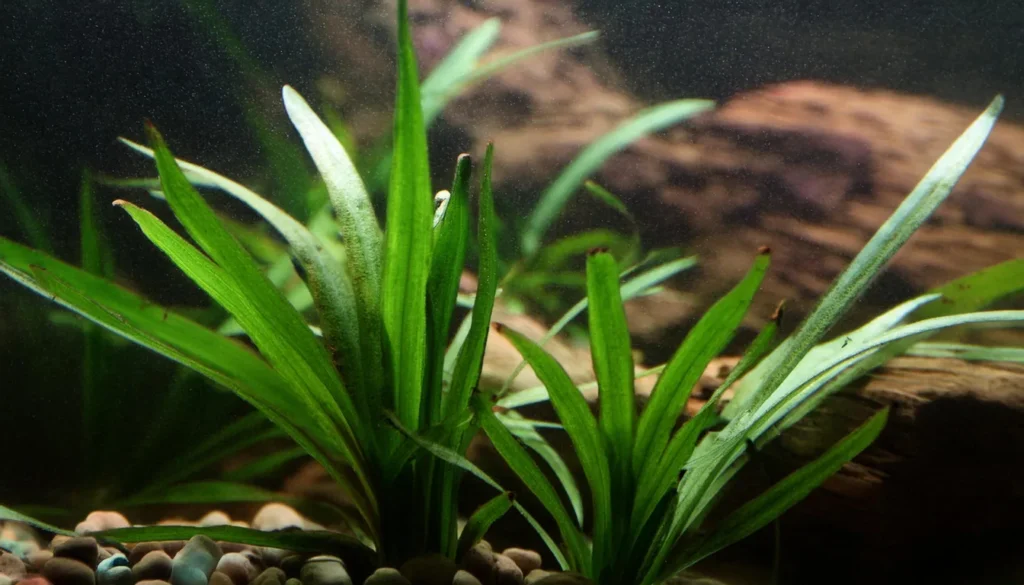
Conclusion
Caring for Cryptocoryne Lucens requires attention to various aspects, such as lighting, water temperature, pH levels, and propagation methods.
Following this comprehensive guide’s guidelines, you can ensure the healthy growth and vibrant appearance of this beautiful aquatic plant species in your aquarium.
Proper lighting is crucial for the optimal growth of Cryptocoryne Lucens. Providing the recommended lighting duration and intensity will help prevent bleaching and loss of color in the plant.
Furthermore, maintaining a stable water temperature within the ideal range will contribute to its overall health and well-being.
Adjusting the water pH according to Cryptocoryne Lucens’ preferences is essential for its growth and vitality. Additionally, considering CO2 additions can further support the plant’s development and enhance its overall appearance.
Frequently Asked Questions
What Specific Substrate Types And Compositions Are Most Beneficial For Cryptocoryne Lucens’ Root Development And Overall Health?
It thrives in nutrient-rich, fine-grained substrates that allow for easy root penetration and access to nutrients. A substrate composed of clay-based aqua soil or a mix of sand and peat under a layer of gravel works well to support its growth.
The inclusion of root tabs or a nutrient-rich base layer can further enhance nutrient availability, promoting robust root development and healthy foliage. It’s essential to avoid overly compacted substrates, as this can hinder root growth and gas exchange.
How Does Cryptocoryne Lucens React To Different Lighting Intensities, And What Is The Ideal Setup To Promote Its Characteristic Growth?
It is adaptable to a range of lighting conditions, from low to medium intensity. However, it shows optimal growth and coloration under medium light levels, where it develops a lush, vibrant green carpet. Excessive light can cause the leaves to become pale and may lead to algae growth on the leaves.
Ideally, providing 8-10 hours of indirect, moderate lighting daily will encourage steady growth without stressing the plant. Using full-spectrum LEDs or fluorescent bulbs can ensure the light covers the necessary spectrum for healthy photosynthesis.
Considering Cryptocoryne Lucens’ Sensitivity To Water Parameter Changes, How Can Aquarists Best Acclimate And Maintain Stable Conditions For This Plant?
It is known for its sensitivity to sudden changes in water parameters, a condition often referred to as “Crypt melt.” To acclimate new plants, gradually introduce them to the aquarium by floating them in their bag or container, slowly mixing aquarium water over the course of an hour.
nce planted, minimize fluctuations in pH, temperature, and hardness by making any necessary changes to the water chemistry gradually, over several days.
Consistent water quality can be maintained through regular, small water changes, rather than larger, less frequent ones. Monitoring water parameters regularly helps in early detection of any issues.
Can Cryptocoryne Lucens Be Effectively Propagated In An Aquarium Setting, And If So, What Methods Yield The Best Results?
It propagates through the natural process of producing runners or offshoots from the base of the mature plant. To propagate, simply wait for these offshoots to develop a few leaves and a small root system of their own.
Then, gently detach them from the parent plant using a pair of aquarium scissors or tweezers, taking care not to damage the roots. Plant the offshoots in the substrate, ensuring the roots are well-covered while the crown (where the leaves emerge) remains above the substrate.
This method allows for a controlled spread and can help fill in desired areas of the aquarium with new growth.
What Are Common Challenges In Growing Cryptocoryne Lucens, And How Can Aquarists Address These To Ensure Plant Health And Vitality?
One of the main challenges in growing it is dealing with the initial “Crypt melt,” where the plant may lose leaves shortly after being introduced to a new environment.
This is typically a response to stress from changes in water conditions. To mitigate this, ensure gradual acclimation and maintain stable water parameters. Another challenge is nutrient deficiency, which can manifest as slow growth or discolored leaves.
Addressing this involves ensuring a nutrient-rich substrate and possibly supplementing with liquid fertilizers. Algae growth on leaves can also occur under excessive light or nutrient imbalances.
Regular maintenance, including careful control of lighting and nutrients, will help prevent these issues and support the healthy growth of Cryptocoryne Lucens.
- Unveiling The Wonders Of Riccia Fluitans In Aquascapes - August 7, 2024
- Vallisneria Gigantea Var. Guide To Care And Cultivation At Home - July 31, 2024
- Vesicularia Dubyana Care & Growth Guide Tips For Beginner Gardeners - July 30, 2024
